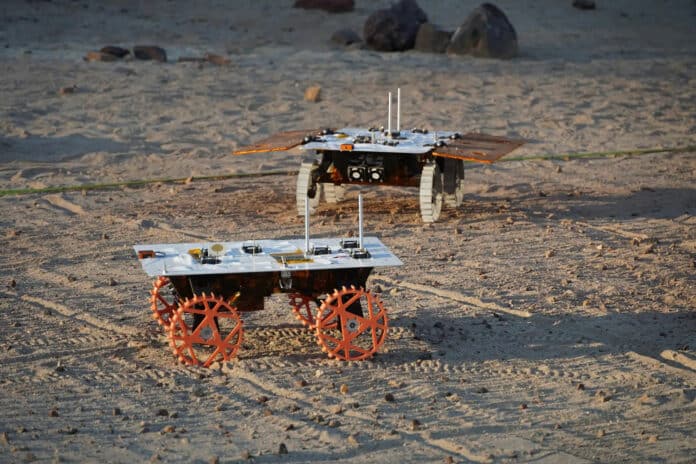NASA has completed the assembly of a trio of planned Cooperative Autonomous Distributed Robotic Exploration (CADRE) rovers that will explore the Moon together. The engineers at NASA’s Jet Propulsion Laboratory then put them through a punishing series of tests to ensure they’ll survive their jarring rocket ride into space and their travels in the unforgiving lunar environment.
Each solar-powered rover, about the size of a carry-on suitcase, will be installed on a lander headed for the Moon’s Reiner Gamma region. They’ll spend the daylight hours of a lunar day – the equivalent of about 14 days on Earth – conducting experiments by autonomously exploring, mapping, and using ground-penetrating radar that will peer below the Moon’s surface.
The goal of the CADRE mission is to demonstrate how a team of robotic spacecraft can work together to accomplish tasks and record data without explicit commands from mission controllers on Earth.
If the project succeeds, it could pave the way for future missions that involve teams of robots taking simultaneous, distributed scientific measurements, which could be incredibly useful for supporting astronauts. Engineers have put in long hours test-driving rovers and preparing them for integration with the lander.
“We have been in overdrive getting this tech demo ready for its lunar adventure,” said Subha Comandur, CADRE project manager at JPL. “It’s been months of nearly round-the-clock testing and sometimes re-testing, but the team’s hard work is paying off. Now we know these rovers are ready to show what a team of little space robots can accomplish together.”
The CADRE mission’s rovers are being rigorously tested to ensure their ability to withstand the harsh conditions of space. They are locked in a thermal vacuum chamber that simulates airless conditions and extreme temperatures. The hardware is also clamped to a special “shaker table” that vibrates intensely to ensure it will endure the journey out of Earth’s atmosphere.
Environmental testing was conducted on the three hardware elements mounted on the lander. The engineers are taking all the necessary measures to ensure that the equipment will function properly in the harsh lunar environment. The base station, camera, and deployer systems all sound like essential components for the mission’s success.
Engineers working on CADRE’s cooperative autonomy software have spent many days in JPL’s rocky, sandy Mars Yard with full-scale versions of the rovers called development models. The full-scale versions of the rovers were able to drive together in formation and adjust their plans as a group when faced with unexpected obstacles.
The project took some interesting steps to test the rovers before sending them to the Moon. They conducted several drives at night under large flood lamps so the rovers could experience extreme shadows and lighting that approximate what they’ll encounter during the lunar daytime.
Then, the team tested flight models in a clean room at JPL, but the robots had to adjust when the spotless floor proved to be a bit slippery. Nonetheless, they were able to proceed on their planned path.
Next, the hardware will ship to Intuitive Machines for installation on a Nova-C lander that will launch atop a SpaceX Falcon 9 rocket from NASA’s Kennedy Space Center in Florida.
